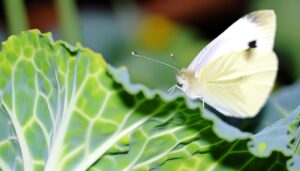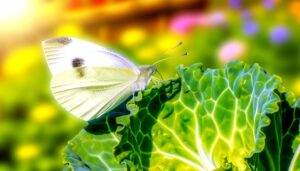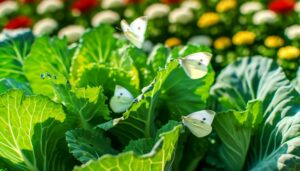Identifying the Cabbage White Butterfly and Its Scientific Name
The cabbage white butterfly, with the scientific name Pieris rapae, is classified under the family Pieridae within the order Lepidoptera. This species is distinguished by its primarily white wings with black tips and one to two black spots on the forewings, which are more pronounced in females.
Members of Pieris rapae also exhibit a notable wingspan ranging from 45 to 50 millimeters. Understanding the taxonomy and physical characteristics of Pieris rapae is fundamental for grasping its ecological role and impact on agriculture.
Additional insights into its lifecycle and behavioral patterns provide a thorough understanding of this pervasive species.
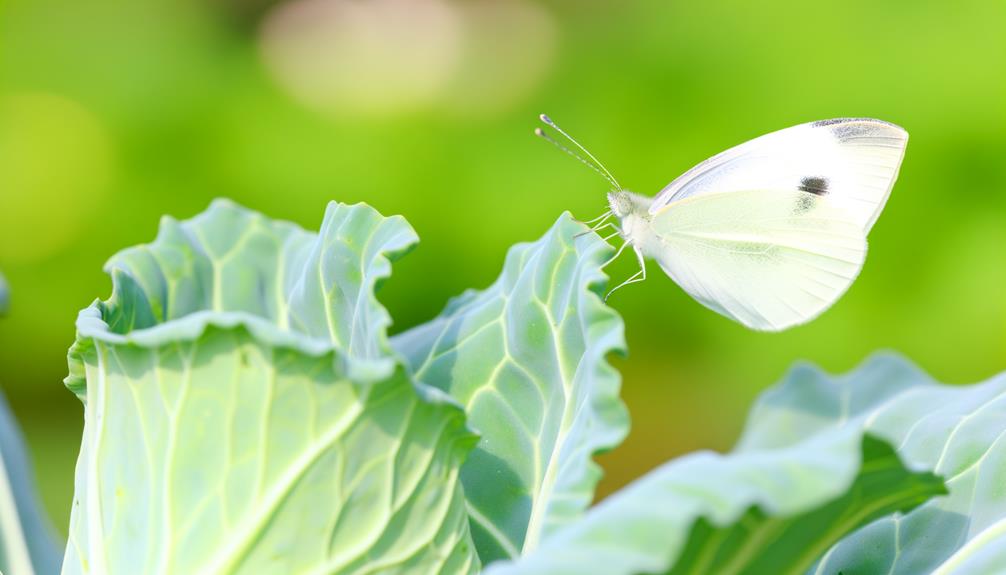
Key Takeaways
- The scientific name of the Cabbage White Butterfly is Pieris rapae.
- Pieris rapae belongs to the family Pieridae, order Lepidoptera.
- There are two subspecies: Pieris rapae rapae and Pieris rapae crucivora.
- It is recognized by its white wings with black tips and spots.
Taxonomy of Pieris Rapae
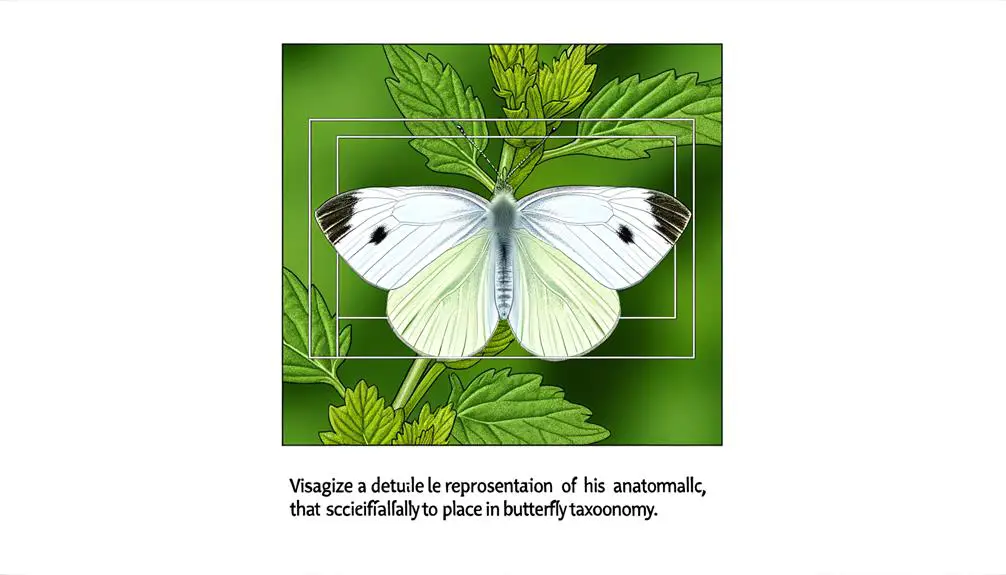
The taxonomy of Pieris rapae, commonly known as the Cabbage White Butterfly, places it within the family Pieridae, order Lepidoptera, and class Insecta. This taxonomic classification is essential for understanding its ecological role and evolutionary relationships.
Pieridae, a family characterized by its mainly white, yellow, or orange members, comprises over 1,100 species worldwide (Gullan & Cranston, 2014).
Pieris rapae is further divided into two subspecies: Pieris rapae rapae and Pieris rapae crucivora, differentiated by their geographical distributions and minor morphological variations (Shapiro, 1974).
Importantly, the genus Pieris is distinguished by the presence of specific wing venation patterns and larval host-plant preferences, which are critical for accurate identification and study (Scott, 1986).
Physical Characteristics
The physical characteristics of Pieris rapae are distinctive and aid in its identification.
The wings are primarily white with black tips and feature one or two black spots on the forewings, which are more pronounced in females (Shapiro, 1975).
Adult wingspans range from 45 to 50 millimeters, and the wings exhibit a slightly rounded shape (Opler & Krizek, 1984).
Wing Color and Patterns
Characterized by their mainly white wings adorned with distinctive black spots, the Cabbage White Butterfly exhibits a pattern that aids in species identification and understanding of their ecological role. This striking contrast not only helps differentiate them from other butterflies but also serves as a form of visual communication among their species. The cabbage white butterfly or moth is commonly found in gardens and agricultural fields, where it plays a role in pollination while also being considered a pest due to its larvae feeding on cruciferous plants. Their adaptability to various environments has allowed them to thrive across multiple continents.
The forewings display one or two black spots, with females generally showing two and males one, as noted by Ford (1945). The hindwings typically remain unmarked but may have subtle veining patterns. These melanistic features are more pronounced on the dorsal surface, contributing to sexual dimorphism.
The ventral side of the wings presents a more subdued palette with light yellow or greenish hues, providing camouflage against predators. This dichromatic wing coloration not only facilitates mating recognition but also serves as a defense mechanism, highlighting the complexity of their adaptive strategies.
Size and Shape
In relation to physical characteristics, Pieris rapae, commonly known as the Cabbage White Butterfly, exhibits a wingspan ranging from 5 to 6.5 centimeters, with a streamlined, slender body structure that enhances its aerodynamic efficiency.
This species is characterized by several distinct features:
- Forewings and Hindwings: Both forewings and hindwings are primarily white with black tips, aiding in camouflage and predator evasion.
- Sexual Dimorphism: Males typically possess one black spot on each forewing, whereas females exhibit two.
- Body Composition: The body is covered in fine scales and setae, contributing to its lightweight structure.
- Antennae and Proboscis: Equipped with clubbed antennae and a coiled proboscis, these butterflies are adept at locating and feeding on nectar.
These traits collectively facilitate their survival and reproductive success in diverse environments.
Lifecycle and Behavior
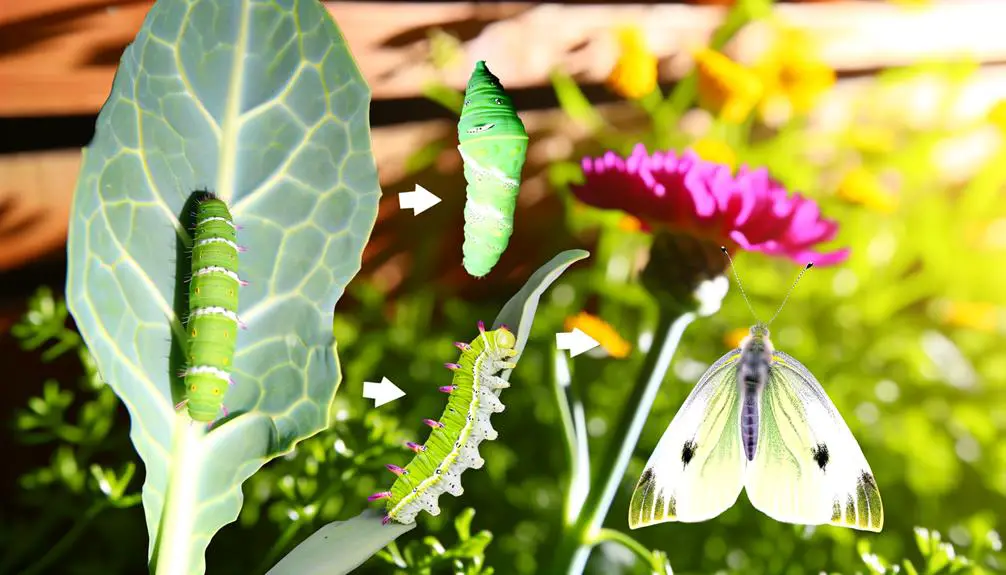
The lifecycle of the Cabbage White Butterfly (Pieris rapae) encompasses distinct developmental stages from egg to adult, each marked by specific behavioral patterns and physiological changes (Baker, 1970).
Mating rituals and reproductive strategies are intricately timed and often influenced by environmental cues, ensuring ideal survival rates (Jones et al., 2015).
Additionally, feeding habits and migratory behaviors are critical for sustaining populations, particularly in response to seasonal variations and habitat availability (Smith & Thompson, 2002).
Egg to Adult Stages
Initiating their lifecycle with the laying of small, yellowish eggs on the underside of host plant leaves, the cabbage white butterfly (Pieris rapae) undergoes a series of developmental stages including larva, pupa, and adult.
The lifecycle progression is as follows:
- Egg Stage: Female butterflies deposit clusters of eggs on Brassicaceae plants.
- Larval Stage: Post-hatching, larvae (caterpillars) primarily feed on the leaves, causing significant agricultural damage.
- Pupal Stage: Larvae enter pupation, forming a chrysalis where metamorphosis occurs.
- Adult Stage: Emerging adults exhibit white wings with distinctive black spots, engaging in nectar feeding and dispersal.
Each stage involves distinct morphological changes and behavioral adaptations, highlighting the evolutionary success of Pieris rapae in varied environments (Owen, 1971).
Mating and Reproduction
Mating behavior in Pieris rapae is characterized by a series of intricate courtship rituals, which include visual and chemical cues to guarantee reproductive success (Shapiro, 1981).
Males utilize their prominent black-tipped wings to engage in display flights, attracting females through both movement and coloration (Rutowski, 1984).
Pheromones play a critical role; males release specific chemical compounds to signal their readiness and suitability for mating (Andersson et al., 2007).
Successful mating culminates in copulation, where the male transfers a spermatophore, containing sperm and nutritional substances, to the female (Watanabe, 1988).
Females subsequently lay eggs on host plants, ensuring the continuation of the lifecycle.
These behavioral patterns underscore the complexity and precision of reproductive processes in Pieris rapae.
Feeding and Migration
Feeding habits in Pieris rapae revolve around their preference for cruciferous plants, which provide essential nutrients for larval development and adult sustenance (Root & Kareiva, 1984). The larvae consume leaves, leading to significant agricultural impact, while adults primarily feed on nectar.
Migration patterns in Pieris rapae are influenced by environmental factors, including temperature and food availability.
Key observations include:
- Seasonal Migration: Movement towards warmer areas during colder months.
- Diurnal Activity: Active during daylight, with feeding peaks in mid-morning and late afternoon.
- Altitude Variation: Higher altitudes during summer months for ideal breeding conditions.
- Dispersal Ability: Capable of long-distance travel, aiding their spread across various continents (Shapiro, 1975).
Understanding these behaviors is vital for effective pest management and conservation efforts.
Ecological Role
The ecological role of the cabbage white butterfly (Pieris rapae) is multifaceted, influencing both plant communities and predator-prey dynamics within its habitat.
As herbivores, their larvae primarily consume members of the Brassicaceae family, which can regulate the distribution and abundance of these plants (Root, 1973). This feeding behavior can result in significant phytophagous pressure, shaping plant community structures.
Additionally, Pieris rapae is an essential prey species for a range of predators, including birds and parasitoid wasps, thereby contributing to the trophic dynamics of ecosystems (Shapiro, 2007).
The butterfly’s interactions with plants and predators make it a key component in maintaining ecological balance, illustrating the interconnectedness of species within biological communities.
Agricultural Impact
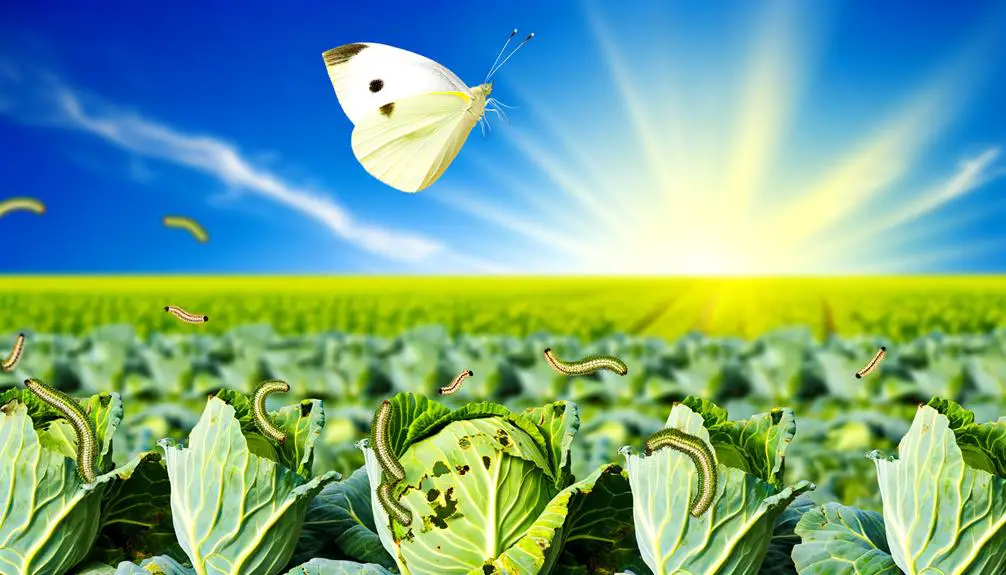
Cabbage white butterflies (Pieris rapae) have a profound impact on agriculture due to their larvae, which are notorious for inflicting considerable damage on crops within the Brassicaceae family, such as cabbage, broccoli, and kale (Capinera, 2001). The pests’ feeding habits lead to significant economic losses and reduced crop yields.
Key agricultural impacts include:
- Crop Defoliation: Larvae consume leaves, reducing photosynthetic capacity, and stunting plant growth.
- Economic Losses: Farmers incur increased costs from pest management and reduced market value of damaged produce.
- Pesticide Use: Elevated reliance on chemical controls raises environmental and health concerns.
- Secondary Infections: Feeding damage provides entry points for pathogens, compounding crop losses (Sarfraz, 2006).
Effective management strategies are essential to mitigate these impacts.
Global Distribution
Pieris rapae exhibits a widespread global distribution, thriving in diverse climatic regions across North America, Europe, Asia, and Australia (Hill, 2007). This adaptability to various environments underscores its ecological versatility and invasive potential.
The species’ ability to colonize a wide range of habitats, from temperate to subtropical zones, allows it to persist and proliferate globally. Detailed studies have mapped its presence extensively, highlighting its role in ecosystem dynamics and agricultural systems (Krebs, 2009).
| Region | Climate Type | Notable Habitats |
|---|---|---|
| North America | Temperate, Subtropical | Agricultural fields, gardens |
| Europe | Temperate, Mediterranean | Meadows, urban areas |
| Asia | Diverse (Temperate to Tropical) | Farmlands, wildlands |
Such widespread distribution necessitates ongoing monitoring to manage its impact on native flora and agricultural productivity.
Conclusion
To sum up, the small but significant Pieris rapae, known commonly as the cabbage white butterfly, exhibits a fascinating fusion of features, functions, and far-reaching effects.
Its lifecycle, behavior, and biological interactions underscore its integral ecological role.
Despite its delicate demeanor, this species demonstrates a detrimental impact on agriculture, demanding diligent management.
The global distribution of Pieris rapae highlights its adaptability and pervasive presence, necessitating continued scientific scrutiny and sustainable strategies for coexistence.

